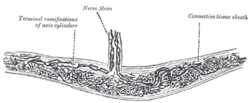- Bulbous corpuscle
-
Ruffini ending 
Nerve ending of Ruffini. Latin corpusculum sensorium fusiforme Gray's subject #233 1061 Code TH H3.11.06.0.00017
TE E05.17.1.0.2.0.15The Bulbous corpuscle or Ruffini ending or Ruffini corpuscle is a class of slowly adapting mechanoreceptor thought to exist only in the glabrous dermis and subcutaneous tissue of humans. It is named after Angelo Ruffini.
Function
This spindle-shaped receptor is sensitive to skin stretch, and contributes to the kinesthetic sense of and control of finger position and movement.[1] It is believed to be useful for monitoring slippage of objects along the surface of the skin, allowing modulation of grip on an object.
Ruffini endings are located in the deep layers of the skin, and register mechanical deformation within joints, more specifically angle change, with a specificity of up to 2 degrees, as well as continuous pressure states.They also act as a thermoreceptors that respond for a long time, so in case of deep burn there will be no pain as these receptors will be burned off. [2]
Footnotes and references
External links
- Paré M, Behets C, Cornu O (2003). "Paucity of presumptive ruffini corpuscles in the index finger pad of humans.". J Comp Neurol 456 (3): 260–6. doi:10.1002/cne.10519. PMID 12528190.
Nervous system, receptors: somatosensory system (GA 10.1059) Medial lemniscus Touch/mechanoreceptors: Lamellar/Pacinian corpuscles – vibration • Tactile/Meissner's corpuscles – light touch • Merkel's discs – pressure • Bulbous/Ruffini endings - stretch • Free nerve endings – pain • Hair cells • Baroreceptor
Proprioception: Golgi organ – tension/length • Muscle spindle – velocity of change (Intrafusal muscle fiber • Nuclear chain fiber • Nuclear bag fiber)
Spinothalamic tract 
This anatomy article is a stub. You can help Wikipedia by expanding it.
